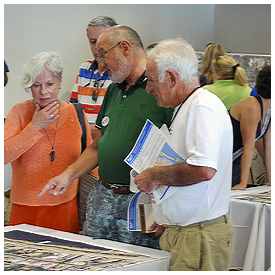Mayor Nancy Shaver provided Historic City News with a compilation of the most commonly asked questions she has received regarding the decision to limit access through the Nelmar Terrace neighborhood, including her responses that were vetted by City management.
The neighborhood identified a possible issue.
The Nelmar Neighborhood approached the city administration stating there was a large volume of traffic along its streets unrelated to the residents. Non-residents were using neighborhood streets as if they were feeder roads, moving large numbers of cars from by-passing through a residential area.
Data confirmed the problem.
A traffic team that included city staff worked with traffic engineers for a five-month period counting cars at different times of the day and different days of the week. Their work documented the inordinate volume of traffic and confirmed the neighborhood’s concerns. Rather than the average traffic load the streets were designed for-up to 700 cars/day, the volume was greater than 1000 cars a day.
Traffic calming was put in place but wasn’t effective.
Four-way stop intersections, speed humps and increased law enforcement all of which reduced speeding in the neighborhood, were put in place more than ten years ago but did not affect volume. (Constant law enforcement is not affordable or practical.) In addition, the accident rate when compared to a similar neighborhood (Davis Shores) was significantly higher.
Is there a problem with emergency vehicle access?
St. Augustine Fire Department and the St. Johns County Rescue agree that residential streets, like the ones in Nelmar, are not used to bypass traffic. And they have well-tested procedures for emergencies when there is traffic congestion on the bridge itself, including medical evacuation. In event access were needed to the neighborhood, emergency vehicles will simply drive over the posts, a feature their design allows.
Is it legal to limit access to City streets?
The city code gives the city manager the right and the responsibility to control traffic on streets in any manner that facilitates traffic movement and safety. One way streets are another example.
How much time did cutting through Nelmar save?
Probably the most astonishing information determined by data collection was the very little amount of time that may be saved under the best of circumstances by those who had used Nelmar’s residential streets to avoid the May St./San Marco Ave intersection. Travel time from the May St./Magnolia Ave. intersection to San Marco Ave., a distance of two tenths of a mile or 1500 feet, was determined to be three minutes under normal conditions. It takes at least two minutes to cut-through the residential area and then one still has to wait for an opening in the San Marco traffic, delaying travel time even more. So the time saved was a minute at best.
But didn’t the cars cutting through help those in line move faster?
Yes, but not by much. Here’s how it worked. A majority of the traffic and May/San Marco turns south to reach US1 based on FDOT analyses. Of the cars headed north those using the cut-through represented about 10% of the total traffic volume. Those cars that cut through did make the line shorter but reduced travel time by only 1-2 minutes in moderate traffic. In heavy traffic—weekend evenings or “Nights of Lights”- when traffic lined up to the far end of the bridge the reduction was just 3-5 minutes. In peak season it’s easy to think that eliminating the cut-through opportunity is to blame for backed up traffic, but the data tells a different story.
| Current Estimated Travel Times | |||
| Traffic Conditions | From Magnolia to San Marco | From Vilano to Magnolia | Total Travel Time |
| Light | 2.5-3 minutes | 2-2.5minutes | 4.5-5.5 minutes |
| Moderate | 2.5-3 minutes | 6-10 minutes | 8.5-12 minutes |
| Heavy | 2.5-3 minutes | 20-25 minutes | 22.5-28 minutes |
There will continue to be traffic challenges in our community and we all will need to adapt our schedules to avoid our own version of rush hour or those weekend days when we know visitation is heavy. There is also a much greater use of WAZE or the traffic feature on Google Maps to check traffic conditions before departing on errands, a very simple way to avoid the shock of gridlock.
Why not wait until the San Marco/May Street project is completed?
It’s no secret that the Florida Department of Transportation (FDOT) will launch work on the reconfiguration of the San Marco Ave./San Carlos Ave./May St. intersection this fall, a project estimated to last two to three years. Postponing the installation of the delineator posts until after the intersection work would only increase the volume of vehicles moving through Nelmar. The city’s traffic team is working with FDOT to limit most construction work to the night hours and to maintain two way traffic, continuing with the level of service that is in place currently.
The good news is that the new intersection design is planned to make backups a rare occurrence in the shorter term. Growth will of course, continue to be a challenge for all roadways.
What about the illegal left turns at Magnolia?
The truth is that we have traffic violations throughout our City, and when our police staff sees them, tickets are issued and in this case the fine is $165. Left turns have been made for many years at that street, so while a hazard exists as it does with many traffic violations, there is no especial increased danger.
Did the limited access solve the problem for Nelmar?
Yes. The goal of maintaining the livability, character and safety of the Nelmar neighborhood was achieved as evidenced by the number of reports of a much greater sense of community in recent weeks as residential characteristics are returning with children playing outside and neighbors more inclined to walk and bike safely. It’s also worth noting that many trips for the residents now take a minute or two longer as well.
Discover more from HISTORIC CITY NEWS
Subscribe to get the latest posts sent to your email.




